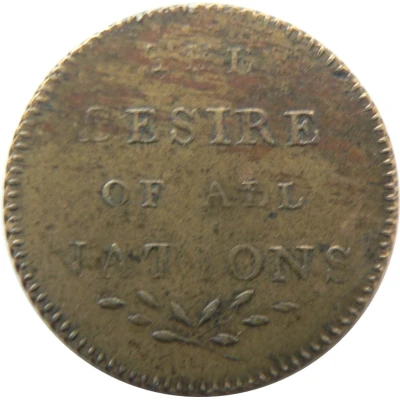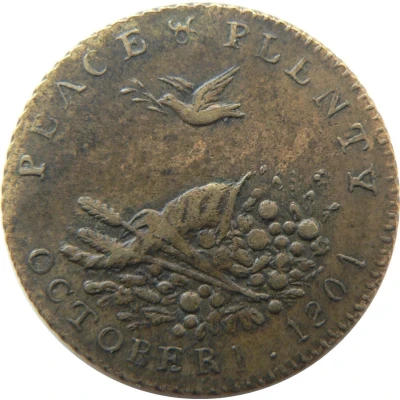


© apuking (CC BY-SA)
Medal - Preliminaries of the Peace of Amiens
1801 year| Bronze | 27.33 g | 38 mm |
| Location | United Kingdom (United Kingdom, British Overseas Territories and Crown Dependencies) |
|---|---|
| King | George III (1760-1820) |
| Type | Commemorative medals › Military medals |
| Year | 1801 |
| Composition | Bronze |
| Weight | 27.33 g |
| Diameter | 38 mm |
| Shape | Round |
| Technique | Milled |
| Orientation | Medal alignment ↑↑ |
| Updated | 2024-11-14 |
| Numista | N#202796 |
|---|---|
| Rarity index | 97% |
Reverse
A classical, robed Eirene the Goddess of Peace, standing half right upon a quay, holding an olive branch in right hand, and emptying a cornucopia cradled under left arm; a bale at her right side and a barrel with lettering on top, behind are rigged ships at sea - one at anchor on left and two sailing on right. In double exergue: crossed ears of corn.
Script: Latin
Lettering:
THEY SHALL PROSPER THAT LOVE THEE
TO FRANCE
Engraver: Henry Kettle
Edge
Plain
Comment
Made by H Kettle, medallist, of Kettle & Sons of Birmingham. There is a bronze version in the Royal Collection.Also in silver, and gilded bronze.
Notes: France had declared war on the United Kingdom in 1793 during the French Revolution, and the Treaty of Amiens temporarily ended those hostilities during the Napoleonic Wars. A preliminary agreement was signed in London on 30 September 1801 by Lord Hawkesbury (Britain) and Louis Guillaume Otto (France), and the Definitive Treaty of Peace was signed at Amiens in France on 25 March 1802 by Joseph Bonaparte (Napoléon’s brother) and the Marquess Cornwallis (Britain). The Peace of Amiens lasted only 14 months and the uneasy truce ended when Britain declared war on France on 18 May 1803.
The Napoleonic Wars and the Treaty of Amiens in particular had a major influence in the early development of South Africa. In 1652 the Dutch East India Company (VOC) had established a settlement in Table Bay. By 1795 the settlement had effectively become a Dutch colony extending over the present-day Western Cape Province but still governed by VOC, and had attained vital strategic importance internationally in the sea trade between Europe and the Far East. In that year The Netherlands fell to the French army under the leadership of Napoléon Bonaparte, and was restructured as a French client-state called the Batavian Republic. Prince William V of Orange fled to Britain and a campaign was launched to secure Dutch colonial possessions from falling into French hands. Britain dispatched an expeditionary force to the Cape led by Vice-Admiral Sir George Keith Elphinstone and with troops under the command of General Sir James Henry Craig. The outcome, after the battle of Muizenberg and skirmishes between June and September, was that the Dutch Governor Abraham Josias Sluysken surrendered the Cape to the British.
The significant part of the Treaty of Amiens for South Africa was that the British should hand back the Cape to the Dutch. The transfer took place in February 1803 and the Cape became an official Dutch colony of the Batavian Republic under Commissioner-General Jacob Abraham de Mist, and the Governor of the Cape of Good Hope, Lieutenant-General Jan Willem Janssens. These two men brought enlightenment to the new Colony and instituted reforms in government, agriculture, trade, coinage, settlement, religion and race relations.
The collapse of the Treaty in May 1803 put the Dutch sovereignty of the Colony under threat. However, the strength of the French Navy deterred any action by the British. The Battle of Trafalgar on 21 October 1805, in which Admiral Lord Nelson defeated the combined navies of France and Spain, changed the balance of sea power. The defence of the Cape could no longer adequately be supported and British warships were sent to recapture the Cape. At the Battle of Blaauwberg near Cape Town on 8 January 1806 the British commander, Lt Gen Sir David Baird, gained a decisive victory and the Articles of Capitulations were signed by Governor Janssens on 18 January. British forces occupied the Cape until 13 August 1814, when the Netherlands ceded the colony to Britain as a permanent possession. It remained a British colony until it was incorporated into the Union of South Africa on 31 May 1910.



